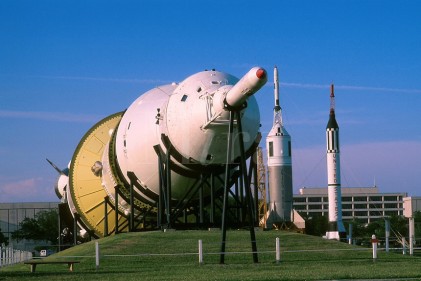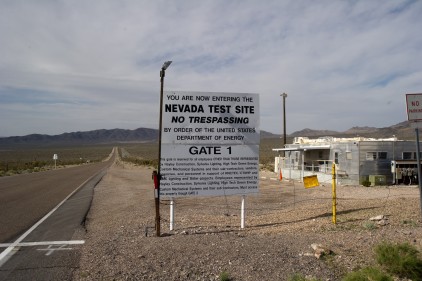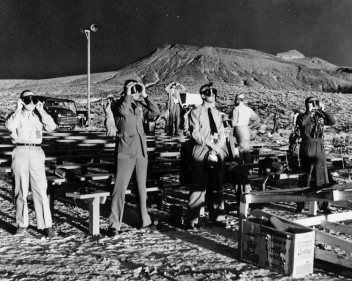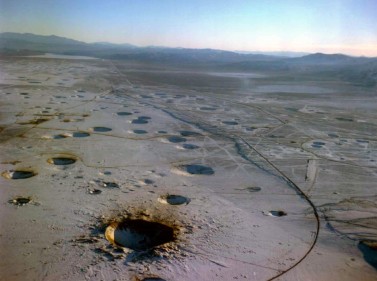The Half Life of Tritium

(The Saturn V booster, with Apollo capsule affixed, took the US to the moon. Photo NASA.)
“Tritium has a half-life of 12.3 years and emits a very weak beta particle.”
– US EPA
I was standing at the Redstone Arsenal a few years ago, back when I had a reason to be in Huntsville, Alabama, besides the fact that I have one of my crazy service buddies who lives there, and raves about the place.
Don’t go all “South Won’t Rise Again” on me. Huntsville and the rocket program of the ‘50s and ‘60s gave that town the distinction of having the highest concentration of PhDs in the country. Anyway, I was looking up at the most amazing machine I have ever seen, close up, beating out even a Nimitz-Class aircraft carrier.
The machine I was looking at was a Saturn V booster rocket, the one powerful enough to send Americans to walk on the mood, hit golf balls and drive around in a cool little car.
And come home. What hit me particularly hard about the rocket was that a learned colleague had a telling comment, which he shared as we walked away. “Pity we can’t make one of those today.”
I looked at him in surprise, even as I realized he was right. Construction of that rocket booster was, at its time, one of the number one priorities of the United States Government. Whatever it took in brainpower and public treasure, we spent.
Once we were done with the moonshots, there was no reason to maintain the physical or intellectual infrastructure to build another. We were done with that, and on to the amazing space truck, the Shuttle.
Now we are done with that, too, and I am not exactly sure what comes next, except that in terms of scale it is going to be smaller. Would you have ever guessed that we would be down to paying the Russians extortion to let us ride their capsules to put us in low-earth orbit? Amazing.
But oh well. I was sitting in a Senate Appropriations panel meeting in the attic of the Capitol one time, and then-National Reconnaissance Office Director Keith Hall was getting grilled on how we had come to a single point of failure on space launch. Keith shrugged, and said: “A perfectly reasonable series of budget decisions, Senator.”

Anyway, I was of that generation of earnest young officers who were part of the perfectly reasonable series of budget decisions that impacted the National Strategic Nuclear Deterrent as part of the command and control system that safeguarded the US nuclear stockpile, and ensured that the doctrine of “Assured Mutual Destruction” was a real capability.
I am not a huge fan of nuclear weapons. I know a little about them, both in theory and reality. We got a physical chill when we walked at ground zero at Nagasaki, and then a sense of the amount of effort that had gone into the program at the Nevada Test Site.
We visited there with some House staffers who wanted to be escorted by one of the Services, rather than the usual Department of Energy monitors. The staffers felt that they cramped their style. While on the reservation, we visited Yucca Mountain, where the used fissile products were to be stored forever.

(Spectators at one of the hundreds of above-ground tests at the Nevada Test Site).
Also on the reservation were some of the creepy landmarks of the Cold War: the bleachers where spectators sat for the famous “Sedan” blast in July of 1962. That was the final above-ground test. Then some Corps of Engineer Army hard-rock miners- the last of their line- took us underground through the tunnel that supported the last underground test, HUNTERS TROPHY, in September of 1992.
All that came to a halt on October 2, 1992, when President George H.W. Bush signed the testing moratorium amendment to a comprehensive arms control treaty.
President Bill Clinton put the stake in the heart of American nuclear testing when he signed the Comprehensive Test Ban Treaty (CTBT) that prohibited nuclear weapons test detonations for everyone except Israel, India, Pakistan, North Korea and soon the Iranians. Just kidding. All that stuff is sort of a violation of the treaty, you know?
The U.S. Congress has never ratified the CTBT, but we were effectively out of the nuclear business, or at least of the fabrication of new weapons to replace the old.
At the time, we earnestly assured everyone not to worry about the half-life of tritium, the exotic radioactive gas that is used as the trigger for many classes of nuclear weapons. As noted above, the half-life of tritium is only a little over a dozen years, which is to say that any tritium that was around in 1990 is only a quarter as potent as it was then.
Tritium is critical to all this horror. Just a few grams of the gas, injected into the hollow pit of a warhead’s primary stage initiates a chain reaction and trigger a much more powerful secondary stage. If a warhead’s tritium-dispenser bottle has been removed, or if the gas has significantly deteriorated, the secondary stage could fail to ignite and the explosive power of the weapon would be considerably diminished.
So that was the question we had at the time, which was ‘stockpile stewardship.” Like, how do we know the things work? We were assured that computer simulations would take care of things, just like they accurately predict global warming- hahaha.
How embarrassing it would be if you came to a place where they had to be used and they didn’t work!
Anyway, the second Bush administration got us back into tritium production in 2004 as the inventory was starting to get a little long in the tooth. If they had not, we would have gone through another degradation of the tritium by a factor of almost another half-life.
I don’t like nuclear weapons. I think they are scary: always have and always will. But I saw something that really surprised me, considering the level of controversy about nearly everything these days.
Our pal Bill Gertz popped up in his “Inside the Ring” column in the conservative Washington Times yesterday. He claimed that the last US warhead had been built in 1990, and our nuclear program is right there with the Saturn V booster, which is to say, the industrial base that supports fabrication of nuclear weapons is no longer there. Considering the rush of our enemies to become nuclear-equipped, that fact fills me with unease.
I would go on to discuss what is happening in Congress, and in the missile fields of North Dakota, but that is going to have to wait until tomorrow. In the meantime, I am opposed to the use of nuclear weapons in almost any context.
But I do think that if we have them, they probably ought to work, right?

(Nevada Test Site. The large crater in the foreground is the result of the Sedan test. Really amazing to see from the rim. Photo Nevada test site.)
Copyright 2013 Vic Socotra
www.vicsocotra.com
Twitter: @jayare303
